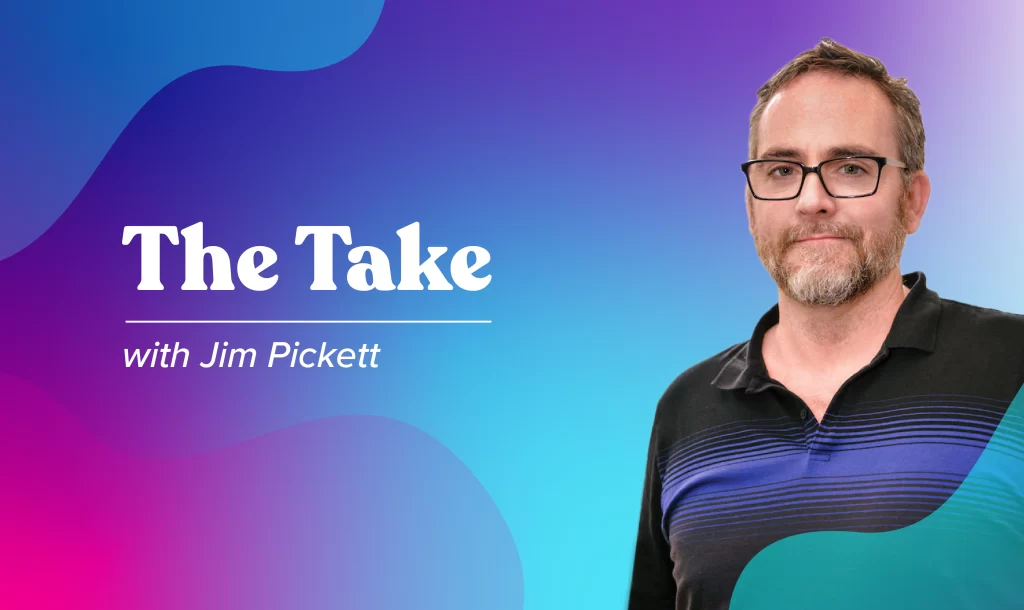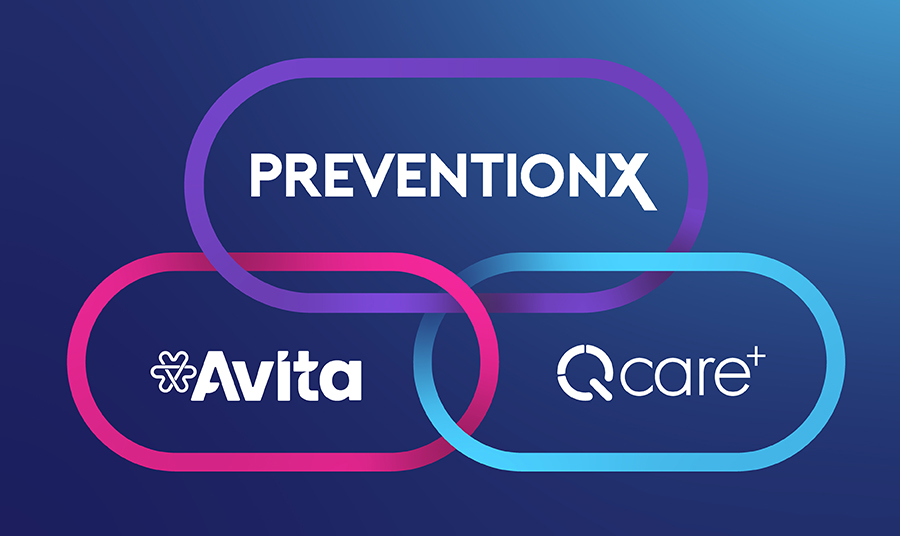In July of 2012, the FDA approved the first drug combination for daily use by adults to prevent the sexual acquisition of HIV. While pre-exposure prophylaxis—or PrEP as it’s widely known—passed at least 15 clinical trials and was found to reduce the risk of acquiring HIV from sex by 99%, at first it was met with confusion, controversy, and a serious dose of stigma. In this month’s “The Take,” Avita’s Glen Pietrandoni talks to longtime PrEP advocate Jim Pickett, who POZ magazine has called “a soldier, instrumental in fighting for much-needed new prevention methods, undeterred by subjects many would prefer to ignore.” On the agenda? Educating skeptics during PrEP’s early years, what’s coming down the clinical and advocacy pipelines, and why the battle for accessibility and uptake is far from over.
It was a revolutionary moment in the global HIV story to finally have a way to prevent HIV that was not a condom.
- Jim Pickett
Glen: It’s the 10th anniversary of PrEP! I can’t believe it’s been 10 years. I remember when the FDA approved PrEP back in 2012. It was a completely new thing for people to even think about a pill as a prevention tool; the focus was on condom use and HIV treatment. Tell me about the initial reaction to PrEP, both within the HIV movement and in a broader sense.
Jim: You nailed it, Glen. It was a revolutionary moment in the global HIV story to finally have a way to prevent HIV that was not a condom. External or internal condoms are great, and they work well. But the fact is that a huge portion of the planet doesn’t like to use them. We were forcing this one-size-fits-all solution on people and saying it was what they had to use for their entire sexual lives. That this was not a winning strategy was obvious: If everyone was using condoms, we wouldn’t have an HIV pandemic, unwanted pregnancies, or many STIs.
But a lot of people [within the HIV advocacy community] weren’t ready for PrEP. When we started to talk about biomedical prevention, there was a lot of pushback. There were a lot of people who were freaking out about it in the HIV world, let alone in the broader world. In fact, I often found less people freaking out in the broader world, because they could say, “Yeah, we understand it, it’s like contraception and taking a daily pill to prevent unwanted pregnancy.” That being said, in today’s world we are still freaking out about contraception.
We saw the same thing with PrEP in the beginning. Prescribing a pill to prevent this disease just brought out a lot of people’s fears. There were fears about pharma taking over. People said, “Pharma has the market with people living with HIV, and now pharma is scooping up everyone who’s negative. So, no matter what you are, you’ve got to take a pill. Isn’t that great for pharma?”
Ten years in, we've made enormous strides globally and within the U.S. But the fact is that there are still far too few people who are taking PrEP, who know about PrEP, and who are able to jump through the myriad hoops that our health care system makes them overcome to get it.
- Jim Pickett
We’ve come a long way baby, but there’s still work to do
Glen: You’ve been a strong advocate for new HIV prevention technologies for more than two decades. How did the introduction of PrEP impact your work, and how has the acceptance and uptake of PrEP changed since 2012?
Jim: In the early days I was called a shill for pharma. I was routinely attacked, mainly by gay men. A lot of these gay men were, like me, living with HIV. They were infuriated [by the introduction of PrEP], and very distrustful.
So, while it was this revolutionary moment, it’s taken a lot of work to make the promise of PrEP come true. And we still haven’t made it come true for enough people. Ten years in, we’ve made enormous strides globally and within the U.S. But the fact is that there are still far too few people who are taking PrEP, who know about PrEP, and who are able to jump through the myriad hoops that our health care system makes them overcome to get it. The people we are not serving fairly or equitably are Black and Brown gay men, Black and Brown transgender women, and Black cisgender women—all communities who continue to face an HIV epidemic that is significantly more acute for them compared to gay white men and the general population.
We’ve come a long way, baby. Things are a lot better than they were 10 years ago, and we should be happy for that. But it’s no time to rest on our laurels, because there’s so much work to do. There are so many people who can benefit from this intervention, but who for all different kinds of reasons—small and enormous—don’t have access to it.
There's the stigmatization of [PrEP], but even deeper is the stigmatization of HIV.
- Jim Pickett
PrEP’s global impact
Glen: Before we get too much into its impact in the United States, what was happening globally with PrEP after it was approved? Were there other countries that adopted it differently than the United States?
Jim: Not in 2012. The United States was the first country to approve it. Other countries were much slower. Most countries where HIV is an issue and where there is HIV data now have PrEP programs. But wherever you are, we’re all facing some of the same issues: There’s the stigmatization of the drug, but even deeper is the stigmatization of HIV.
That the drugs used to prevent HIV are also prescribed to treat people living with HIV is an especially gnarly mess, and this is pretty routine globally. HIV-negative people don’t necessarily want to be associated with people who are positive. People see them [taking PrEP] and assume they’re HIV positive, which has a negative stigma to this day pretty much everywhere.
So, while the rest of the world has been slower to adopt PrEP, they’re facing some of the same communication, education, and uptake battles as the United States in terms of how you actually deliver and implement it.
There's still this idea that providers need to have some super special certificate or training to prescribe PrEP, and that's not true.
- Jim Pickett
The endless prescriber circle
Glen: While this has changed with the broadening of many community health centers into sexual wellness, traditionally the doctors prescribing PrEP were the HIV treatment doctors, and people did not necessarily want to go to an HIV clinic to get an HIV prevention med. These doctors, on the other hand, were busy taking care of people who were HIV positive; they didn’t need the extra foot traffic to care for HIV negative patients. So, that in itself was a stigma.
Jim: You’re right. Which providers were most amenable to understanding HIV drugs and had a background in prescribing them? Infectious disease (ID) doctors. But infectious disease doctors treat people with infectious diseases. If you’re HIV-negative, you don’t have an infectious disease they can treat. So, we saw people getting caught in this terrible circle. You go to your GP, and they say, “Oh my God, I don’t know anything about HIV drugs. I can’t prescribe that, you have to go to the specialist.” Then you go to the specialist (the ID doctor) and they say, “You don’t have HIV. I can’t serve you; I have a full caseload.” People were getting caught in an endless circle where everyone is pointing to someone else, and no one is taking responsibility for the person standing there asking for access. That alone was a huge turnoff for people.
Imagine you’re a 21-year-old, and you’re caught up in that loop. Are you going to continue to try and figure that out? No, you’re going to be turned off. You’re being given the message that PrEP is not available to you, that there’s no one who wants to prescribe it to you. While we have improved in this respect a little bit, there’s still this idea that providers need to have some super special certificate or training to prescribe PrEP, and that’s not true. It’s incredibly easy to prescribe PrEP. Providers don’t need to know anything special. There’s lots of guidance from the CDC. Yet there’s still this idea that it’s someone else’s job.
There were challenges around [PrEP] education and awareness among all kinds of providers. We had been programming people since the late 80s and early 90s that the gold standard for prevention was a condom you use every time. So, we’re also having to unravel all of that.
I used to have to do this a lot more than I do now, but it still comes up: People still refer to people who are using PrEP for prevention as having unsafe sex. We’re so programmed that safe sex is about a physical barrier (a condom). At every layer, from the communities who can benefit from [PrEP] to everyone who provides it, as well as policy makers, funders, and people who lead agencies and organizations, it was hard to get their heads around it.
We’re doing a disservice to everyone if we’re not being honest. The only reason the U.S. government spends billions of dollars on HIV prevention—including vaccines, shots, and pills—is because people don’t love condoms. Now we’re going tell people who hate condoms, who aren’t using condoms, that they have to use a condom and take a pill a day? Is that not crazy? In the early days, it was, “No, that’s not crazy, that’s how you’re supposed to do it.” I felt fairly alone at times pointing out that insanity.
We have to be better at reaching all the different groups that could benefit from PrEP...We have to speak to people directly. We can't expect [one group to see another demographic's] social marketing and think it will fit them.
- Jim Pickett
The importance of tailoring PrEP messaging
Glen: You’re bringing back memories. But we have had some successes with PrEP, especially within the gay community. People are hearing about it through word of mouth, younger people are learning about it via things like Grindr. They’re getting the message loud and clear, they have access, and they’re more likely to have insurance. We’ve had some successes in that community. What about other demographics?
Jim: It’s still not matching, where the HIV epidemic in this country is and where the PrEP uptake is. There’s a mismatch for the 24 and under set. We have a higher percentage of HIV infections in that group than are actually taking PrEP. And that’s because we haven’t done a lot of outreach work specifically for younger people. I worked on a PrEP social marketing campaign (PrEP 4 Love) for people 18 and above, but it didn’t reach younger individuals. We have people getting infected with HIV at age 13.
The PrEP4Love campaign wasn’t designed for adolescents. That’s because back when we started creating the campaign PrEP wasn’t approved for adolescents. The adolescent approval came six years after adult approval.
An initiative I’ve been working on with Northwestern University, AIDS Foundation of Chicago, CORE Center, People Who Care, and Lurie Children’s Hospital is called Prep4Teens. The project was inspired by the Prep4Love campaign, both in its community essence and how it was developed. We’ve been working with teens for the last year and a half, developing a specific campaign around what PrEP messaging could look like for them. And now we’re able to include injectables into that mix.
When teens looked at the Prep4Love materials, they responded well to them. But they were very clear that they don’t see themselves in that campaign. Teens have very different needs in terms of communication and marketing. So we’re working on that now and hope to be able to launch one of the first, if not the first PrEP social marketing campaign for teens and adolescents in the country.
We have to speak to people directly. We can’t expect [one group to see another demographic’s] social marketing and think it will fit them. That’s one reason we don’t have a lot of cis-gendered women on PrEP. There’s been astonishingly little effort put forward to that population. They see lots of campaigns for gay men and trans women, but they don’t see themselves fitting in there, and that’s our fault. We have to be better at reaching all the different groups that could benefit from PrEP.
Something that is so important about PrEP is the peace of mind that comes with it. For gay people and people who are vulnerable to HIV, having your sex life completely intertwined with HIV all the time is really an incredible burden to bear. You are at your most vulnerable, most intimate, feeling all those feelings of love, lust, and excitement, but you're also thinking "I could die." HIV is right on that pillow next to you.
- Jim Pickett
PrEP puts the person before the disease
Glen: Recently you sent me a piece on the importance of using person-centered language—putting the person before the disease. How does that impact PrEP uptake?
Jim: One of the things I’m proud of about Prep4Love is that our focus was around pleasure and intimacy. It wasn’t about “reducing your risk” of getting HIV and making it all scary. It was more about having the kind of sex you want to have and enjoying your sex life. We were inspired by research that was conducted by Dr. Sarit Golub. Her team interviewed young, gay Black and Brown men who showed up to the clinic for PrEP about what their motivations were. And their top motivation was intimacy—the ability to be in the moment [while they were having sex].
Something that is so important about PrEP is the peace of mind that comes with it. For gay people and people who are vulnerable to HIV, having your sex life completely intertwined with HIV all the time is really an incredible burden to bear. You are at your most vulnerable, most intimate, feeling all those feelings of love, lust, and excitement, but you’re also thinking “I could die.” HIV is right on that pillow next to you. HIV is constantly there, it is never not there.
[PrEP means] HIV doesn’t have to be in the room with you. You’ve taken your pill, you’re good. You don’t have to worry about messing with a condom and the mechanics of that. People were just blown away by having that peace of mind given back to them. When they’re having sex, they can set aside HIV. And what an amazing thing to be able to set aside a specter of death, and dying, and horror.
Framing is really important when you talk to people. Why do some people get to have sex, and other people have “risk behaviors”? Can we flip the script, and still take sexual health seriously? To be sexually healthy means you get to have the sex you want to have. The WHO has pleasure in their definition of sexual health, and they’re not a bunch of wild, crazy activists up in Geneva. I think we could all stand to do a lot more with framing our efforts around that.
A lot of people weren't ready for PrEP. When we started to talk about biomedical prevention, there was a lot of pushback.
- Jim Pickett
The PrEP clinical pipeline
Glen: Let’s talk a bit about the PrEP pipeline.
Jim: We have the longer-acting injectable cabotegravir, which is delivered every two months. This is a wonderful advancement, and is incredibly safe and effective based on enormous clinical trials. But it has significant challenges in the delivery. We are now asking people to come in six times a year for a shot. I’m HIV positive, and I see my doctor twice a year, so there’s a bit of a disconnect there. It’s not only a lift for the people who want to take it, this is also a huge lift for clinics to bring in folks that often.
While it’s been approved since December of 2021, we don’t have a lot of people on the [longer-acting injectable]. There’s a lot of confusion around how it’s paid for, if it’s a pharmacy or a medical benefit. That makes it hard on the clinics. A lot of insurance is still not up to speed on it yet. We have to make this work for people. I know the WHO is going to release guidance on it very soon, which will be helpful for countries outside the U.S.
In terms of what else is in the pipeline, we have a dapivirine vaginal ring, which unfortunately will not be available for U.S. women. It was taken out of consideration from the FDA, which was a big loss. It has been approved and is starting to roll out slowly in a number of Sub-Saharan African nations. Right now it’s a monthly ring, and there’s work underway to test it for lasting three months.
Then there’s something called a DPP, the Dual Prevention Pill, which involves formulating two drugs into one pill for HIV prevention and contraception. Because these drugs already exist, they don’t have to do a huge amount of clinical testing, only what we call bioequivalence testing. We should know the bioequivalence data in the next couple of months, and we could potentially have a DPP available for women soon.
In terms of further down the PrEP pipeline, we have the lenacapavir injection being worked on. What’s exciting about this is that it’s only two injections per year, which is potentially a lot easier to implement and stay adherent to. So, we’re excited about that.
Another drug called islatravir was being tested for both treatment and prevention. On the prevention side, it was going to be delivered as one pill once a month. But that drug has been put on clinical hold because of some concerning side effects. Hopefully they’ll be able to reformulate it, because a long-acting pill could have a huge impact. That’s a “watch this space” kind of situation.
We need to offer people information, reminding folks that science is a process.
- Jim Pickett
MPX: "Science is a process"
Glen: What are your insights on the buzz around MPX or monkeypox, and how it’s impacting gay men? How do we stop the stigmatization of a new virus?
Jim: That’s a tricky one. MPX is not an STI. It’s transmitted from close contact. So the messaging around it is very important. I’ve seen some good examples. There’s this really great flyer from the CDC that talks very clearly to gay men about how to think about monkeypox, how to take care of yourself, and how to live your life while still keeping yourself healthy. We have to find that balance. We don’t want to ignore it and put our head in the sand. We also don’t want to clutch our pearls, scream, and say, “Oh my God, this is GRID (gay-related immune deficiency).” Histrionics are not a good strategy.
We just need to be clear and direct, and say what we know and don’t know, because we don’t know a lot about this. We know it can be spread through clothing, through sheets. It’s not about gay sex, it’s about being close to each other.
One of the things I’ve found interesting in this whole discussion is that gay men are so sensitized to HIV and STIs that when they do see a sore or a lesion on their body, they go to the clinic. They’re kind of trained to do that. So, it may be that gay people are the canaries in the coal mine. It could actually be spreading further, and we just don’t know yet because others haven’t come forward. We need to offer people information, reminding folks that science is a process, and that it may tell us something new about monkeypox we didn’t know a week ago.
There's huge energy around helping people who are uninsured and underinsured easily get access to PrEP. Demand creation is a big part of that, including provider education and awareness, as well as an expansion of where PrEP is delivered.
- Jim Pickett
Plans for a national PrEP program
Glen: What else is on the horizon in terms of PrEP?
Jim: A huge opportunity is in front of us right now in that we have a generic form of PrEP. The cost savings we can realize from that are enormous, and we can use that to build a national PrEP program. The Biden-Harris administration has indicated it wants to invest $9.8 billion dollars over 10 years to expand access to PrEP. Now, it’s up to advocates and legislators to find that money to make it happen.
But there’s huge energy around helping people who are uninsured and underinsured easily get access to PrEP. Demand creation is a big part of that, including provider education and awareness, as well as an expansion of where PrEP is delivered. This initiative would cover all the essential services that are a part of the PrEP program, and could also help with ancillary services like transportation. It’s a heavy lift to make this come true, but there are a ton of advocates, with incredible leadership at PrEP4All, working on it right now across the United States.
We've come a long way, baby. Things are a lot better than they were 10 years ago, and we should be happy for that. But it's no time to rest on our laurels.
- Jim Pickett
About Jim Pickett:
Jim Pickett, who has been living with HIV since 1995, is a senior advisor to AVAC and a consultant working on domestic and global advocacy in support of prevention research and the implementation of new modalities. His efforts in this space have been ongoing for more than two decades, including working at AIDS Foundation Chicago for 17 years and a six-year consultancy with the Chicago Department of Public Health. He led the development and implementation of Chicago’s renowned PrEP4Love social marketing and community mobilization campaign and continues to work on the PrEP4Teens project with Northwestern inspired by PrEP4Love. POZ magazine refers to him as “a soldier, instrumental in fighting for much-needed new prevention methods, undeterred by subjects many would prefer to ignore.” He was inducted into Chicago’s Gay and Lesbian Hall of Fame in 2005.
About Glen Pietrandoni:
Glen Pietrandoni is SVP of patient and community advocacy at Avita, where he’s deeply engaged in Avita’s mission as an industry advocate and thought leader for HIV patient care and continuation of the 340B program benefiting its patients and partners. Glen is responsible for networking with pharma and government officials to represent Avita’s views and discuss industry activity. He leads the efforts to advance Avita Pharmacy programs and continues to look at educational opportunities that improve the health and the lives of the patients we serve. Glen serves on the Board of Pharmacy for the State of Illinois, is Chairman of the Board of Trustees of AIDS United, and sits on the board of CV340B. He has earned American Academy of HIV Medicine and Apexus 340B certifications.




